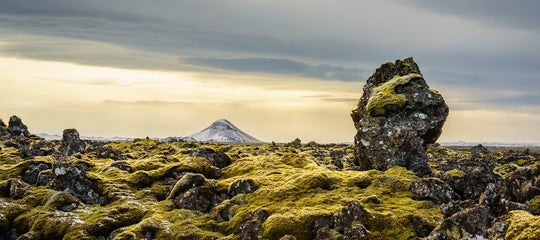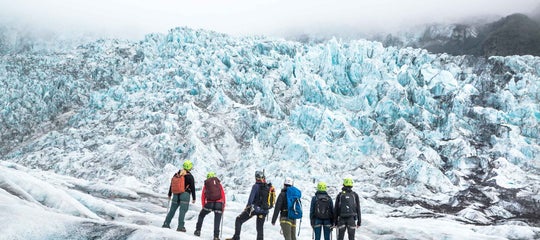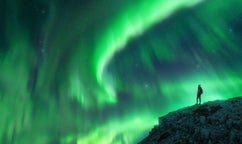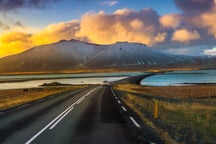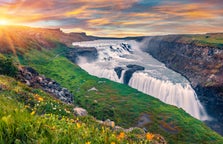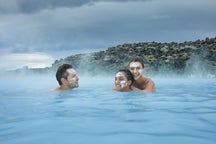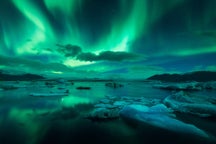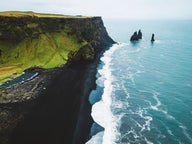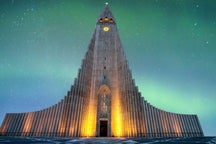Learn everything you need to know about Iceland's Blue Lagoon. Find out what the Blue Lagoon is, how to get there, when it's open, the best time to visit, and other tips for planning your trip in this complete guide.
The Blue Lagoon is the most famous geothermal spa in Iceland, offering a unique bathing experience surrounded by nature. It's known for its mineral-rich, milky-blue waters, which are said to have great skincare benefits.
Why You Can Trust Our Content
Guide to Iceland is the most trusted travel platform in Iceland, helping millions of visitors each year. All our content is written and reviewed by local experts who are deeply familiar with Iceland. You can count on us for accurate, up-to-date, and trustworthy travel advice.
There's a large selection of Blue Lagoon tours and packages to choose from for your visit. The most popular and affordable admission option is the Blue Lagoon comfort ticket. For a more luxurious experience, you can book the premium entrance to the Blue Lagoon, which has additional amenities.
You can easily visit the Blue Lagoon by transfer, like this shuttle bus from Reykjavik. There’s also a range of Blue Lagoon accommodations available if you'd like to spend more time in the area.
Whether you're looking to relax in Iceland's most iconic spa or discover the surrounding volcanic landscapes, the Blue Lagoon offers a rejuvenating experience surrounded by the natural beauty of Iceland. Read on to learn all about the Blue Lagoon in Iceland!
Key Takeaways for the Blue Lagoon
-
Iceland’s Blue Lagoon is a world-famous geothermal spa known for its rejuvenating warm waters and natural beauty.
-
Guests can enjoy a variety of treatments, including silica mud masks, in-water massages, and exclusive spa services.
-
It’s easily accessible from both Reykjavik and Keflavik Airport, making it an ideal destination for travelers.
-
Upgrade your visit with tours across Iceland, allowing you to explore other Icelandic wonders alongside the Blue Lagoon experience.
What Is the Blue Lagoon?
 The Blue Lagoon is one of Iceland's most popular attractions, and it's little wonder as to why. The beautiful milky-blue water is unlike anything else found on earth and starkly contrasts with the surrounding black lava fields and creeping gray moss.
The Blue Lagoon is one of Iceland's most popular attractions, and it's little wonder as to why. The beautiful milky-blue water is unlike anything else found on earth and starkly contrasts with the surrounding black lava fields and creeping gray moss.
The water temperature in the bathing areas generally ranges between 98–104 F (37–40 C) throughout the year, with slight natural variation by area and weather.
The lagoon is on the Reykjanes Peninsula in Southwest Iceland, renowned for its barren landscapes and cone-shaped volcanoes. It's only a 14-mile (23-kilometer) drive from Keflavik International Airport.
The distance from the Icelandic capital city of Reykjavik to the Blue Lagoon is 30 miles (49 kilometers). That makes it the perfect first stop when arriving in Iceland or the last stop before leaving the country.
Due to its excellent location, soothing waters, and rich skin nourishment benefits, Iceland's Blue Lagoon quickly became the country's most visited attraction, rivaled only by the Golden Circle sightseeing route.
The Blue Lagoon has also become famous internationally and tops many travelers' bucket lists. National Geographic named it one of the top 25 Wonders of the World, and Conde Nast Traveller included it on a list of the best destination spas in the world.
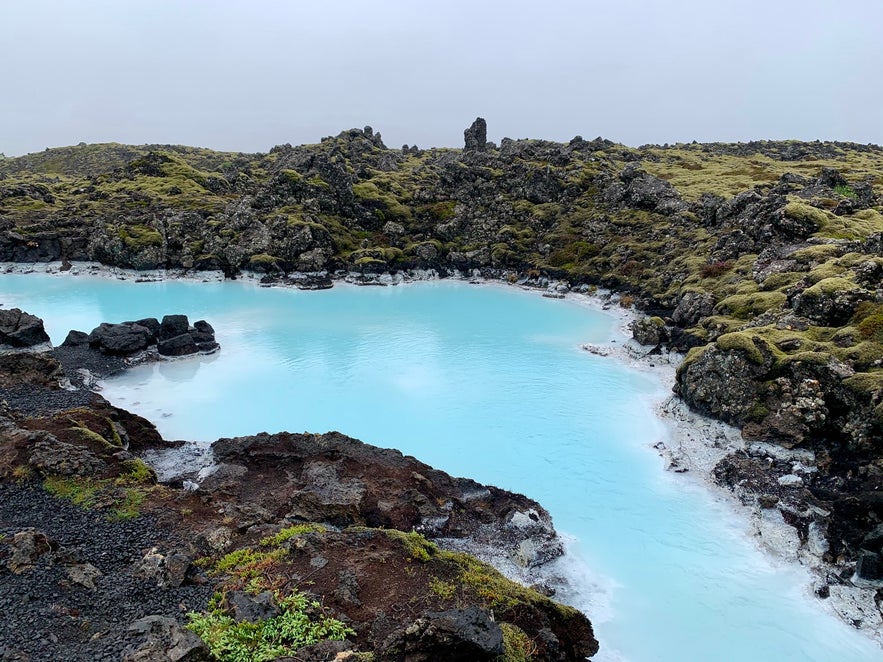
The Blue Lagoon has become so popular that you'll need to book your ticket days (or even weeks) in advance to get in. And who knows, you might be rubbing shoulders with international celebrities when you do go.
Celebrities such as Bjork, Beyonce, Jay-Z, and Kim Kardashian have been spotted in the Blue Lagoon, much to the delight of fellow visitors.
But what's so special about the Blue Lagoon in Iceland? Read on to learn more about its history, the difference between the entry tickets, why it's so blue, and what makes it unique.
- Learn about The 30 Best Hot Springs and Geothermal Pools in Iceland
- See also: The Ultimate Guide to Iceland's Golden Circle
Blue Lagoon Ticket Types
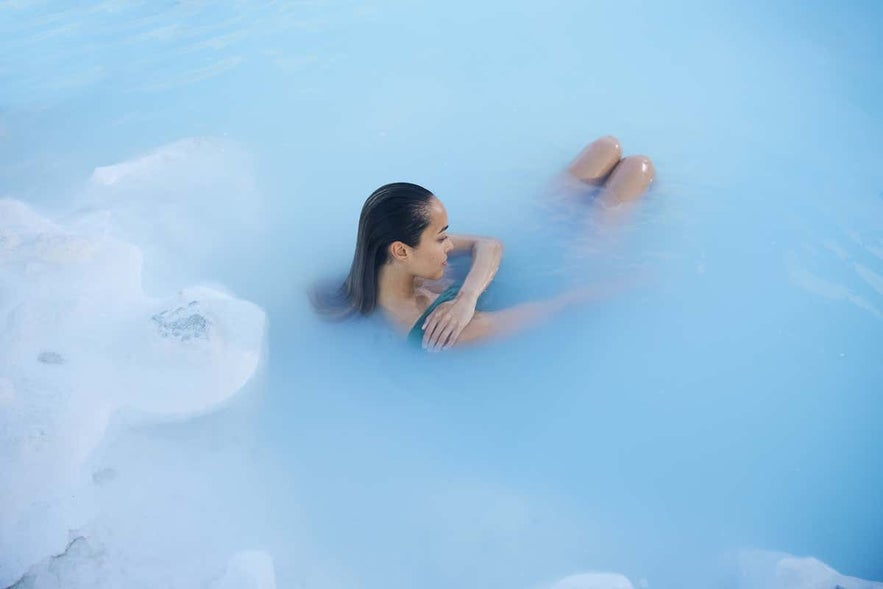 Iceland’s iconic Blue Lagoon offers a rejuvenating escape. Whether you're looking for a budget-friendly visit or a more luxurious experience, there’s a ticket option to suit your needs.
Iceland’s iconic Blue Lagoon offers a rejuvenating escape. Whether you're looking for a budget-friendly visit or a more luxurious experience, there’s a ticket option to suit your needs.
Options include:
-
Blue Lagoon comfort ticket: Enjoy Iceland’s famous Blue Lagoon with a budget-friendly ticket, which includes access to warm, mineral-rich waters, a rejuvenating silica mud mask, towel use, and a drink of your choice.
-
Blue Lagoon premium ticket: For an enhanced experience, opt for the premium ticket, which offers additional face masks, a cozy bathrobe, and more. Take your time exploring the lagoon’s steam rooms, saunas, and relaxation areas.
Visiting right at opening or later in the evening is often more affordable due to dynamic pricing, and there’s no time limit once you’re inside. Booking in advance is essential.
For the most exclusive experience, the Retreat Spa is a separate admission that includes access to the Retreat Lagoon and signature rituals. Note that Retreat Spa access is not included with Comfort or Premium tickets.
How to Get to the Blue Lagoon
After securing your admission ticket, you'll need to arrange how you'll get to the lagoon. If you'd like the Blue Lagoon to be your first stop after you arrive in Iceland, you can reserve a bus transfer from Keflavik Airport to Reykjavik with a stop at the Blue Lagoon.
Alternatively, if you are booking it later in your trip, you can arrange a one-way bus transfer from Reykjavik to the Blue Lagoon and from the Blue Lagoon back to Reykjavik. The lagoon’s official transport partner, Destination Blue Lagoon, also runs frequent shuttles from Reykjavik and Keflavik Airport.
If you plan to rent a car for your stay in Iceland, you can also drive yourself there. The Blue Lagoon is located 30 miles (49 kilometers) from Reykjavik, and the journey usually takes around 50 minutes of driving.
You can also join a tour that combines a visit to the Blue Lagoon with another experience, such as this Golden Circle and Blue Lagoon tour. Note that you will still need to book your entry ticket to the Blue Lagoon yourself for some combination tours.
You can also book self-drive tours for your entire stay in Iceland or vacation packages that include interesting tours and accommodation.
Essential Information for Your Blue Lagoon Visit
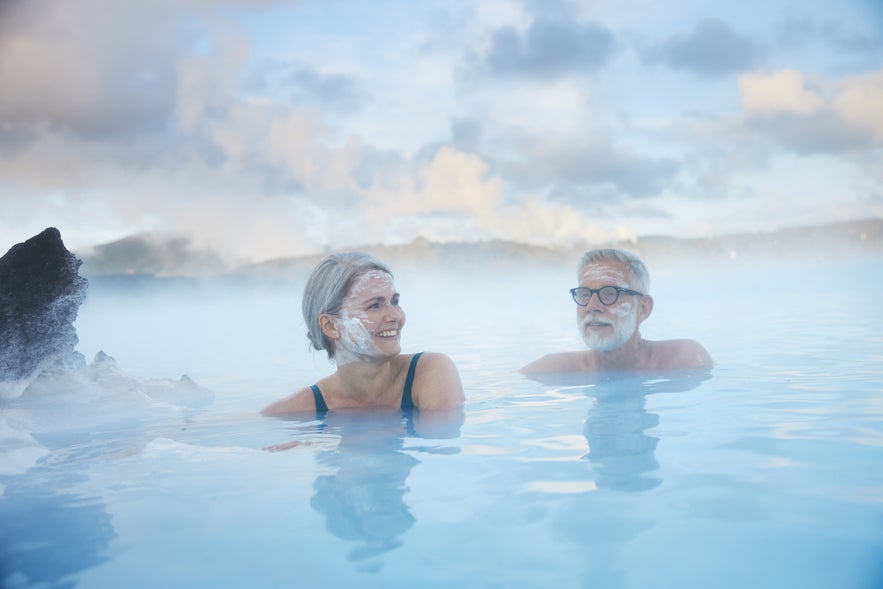 When you enter the main reception building you might have to queue up before talking to a staff member who will hand you an electronic wristband. Depending on the admission type you booked, the staff will give you a towel, bathrobe, and slippers. There is also luggage storage if needed.
When you enter the main reception building you might have to queue up before talking to a staff member who will hand you an electronic wristband. Depending on the admission type you booked, the staff will give you a towel, bathrobe, and slippers. There is also luggage storage if needed.
When you've gone through the reception area, you'll need to take your shoes off and enter a changing room. There are separate changing rooms for men and women, as well as a private, gender-inclusive changing room for those needing more space or wheelchair access.
There, you can take your clothes off and lock them inside a locker using your electronic wristband. You'll need to shower naked before putting on your swimsuit and entering the lagoon. This is standard etiquette at public swimming pools in Iceland. The water doesn’t use chlorine and is part of a self-cleaning ecosystem that naturally renews roughly every 40 hours.
The Blue Lagoon has shower cubicles where you can have some privacy. You'll almost certainly be called out publicly if you try to sneak through without showering.
Leave your towel inside by the showers instead of taking it out to the lagoon with you, as it may be raining or snowing outside, and you can swim between the indoor and outdoor areas.
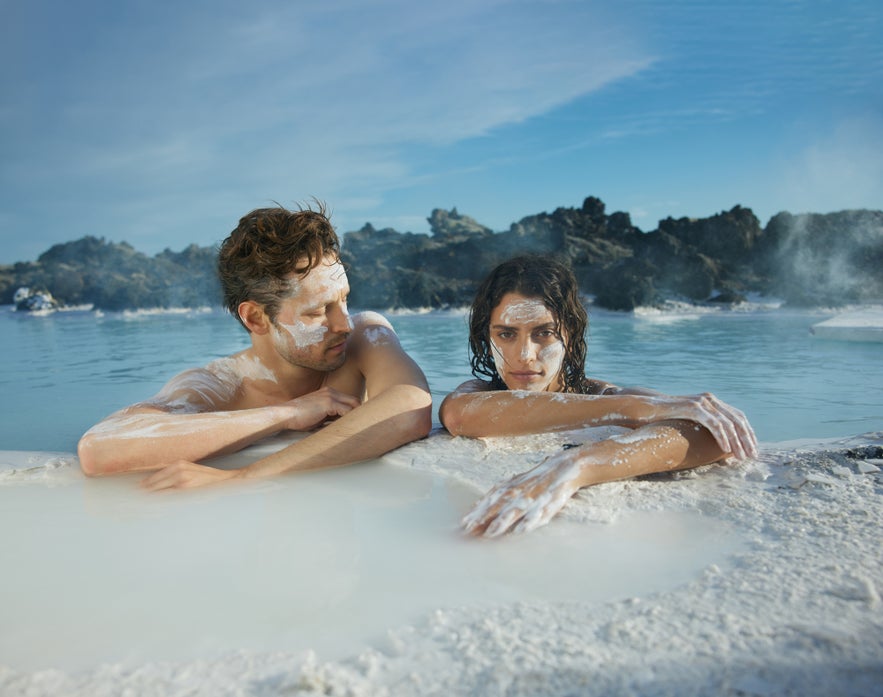 After entering the lagoon, check out the swim-up bar, where you can purchase drinks using your electronic wristband. There is a limit on alcoholic beverages while in the water. There’s also a mud bar, where you can get a silica mud mask for your face (included for all visitors).
After entering the lagoon, check out the swim-up bar, where you can purchase drinks using your electronic wristband. There is a limit on alcoholic beverages while in the water. There’s also a mud bar, where you can get a silica mud mask for your face (included for all visitors).
Additional algae and mineral masks can also be purchased using the electronic wristband. Algae masks are given to visitors who have booked the premium package.
Explore the lagoon, let the water hit your shoulders at the small waterfall by the saunas, and cleanse your skin inside the three different saunas and steam rooms. If you've booked an in-water massage, there's a dedicated place for them by the saunas.
If you're visiting in winter and it's dark outside, remember to search the skies for the northern lights!
Family policy highlights: Minimum age is two years. Children 2–13 enter free with a guardian; ages 2–8 must wear floaties (provided). For safety, one adult may supervise up to two children under 10. The lagoon’s depth reaches about 4.7 ft (1.4 m) in places.
Hair, eyewear, and jewelry tips: Apply the complimentary conditioner before entering and leave it in; silica can make hair stiff. Avoid submerging prescription glasses (silica can damage lenses) and remove jewelry that may tarnish in mineral-rich water.
- See also: When and Where to (Not) Get Naked in Iceland
- Discover The Best Time to See the Northern Lights in Iceland
Maximizing Your Visit to the Blue Lagoon
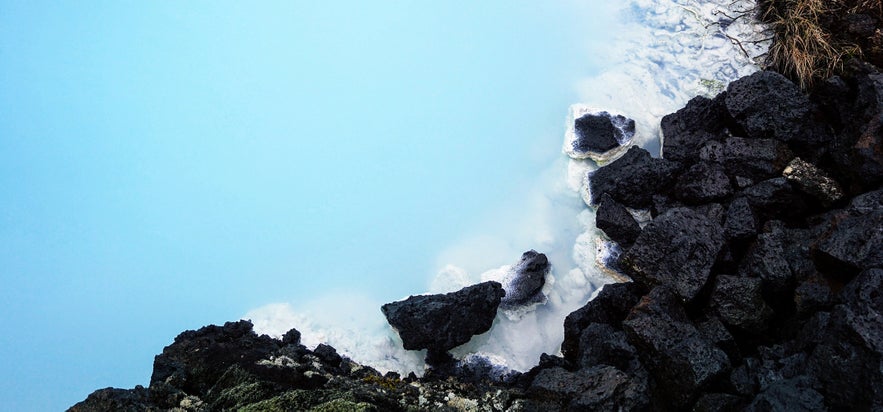 The Blue Lagoon is one of Iceland’s most iconic destinations, offering a relaxing escape in stunning natural surroundings. To make the most of your visit, look into opening hours, spa amenities, the best times to go, and unique experiences like in-water massages.
The Blue Lagoon is one of Iceland’s most iconic destinations, offering a relaxing escape in stunning natural surroundings. To make the most of your visit, look into opening hours, spa amenities, the best times to go, and unique experiences like in-water massages.
Blue Lagoon Opening Hours
The Blue Lagoon is open daily, with hours varying by season:
-
Summer (June 1 – August 20): 7 AM – 12 AM
-
Winter (August 21 – May 31): 8 AM – 10 PM
-
Christmas Eve: 8 AM – 4 PM
-
New Year's Eve: 8 AM – 6 PM
Guests are asked to exit the water 30 minutes before closing. Holiday hours and temporary adjustments can occur—always confirm the latest schedule on the official website, especially during periods of heightened volcanic activity.
When Is the Best Time to Visit the Blue Lagoon?
 Many people wonder when the best time to visit is, both in terms of the time of day and season. The least popular slots tend to be the very first in the morning and the very last at night, so you may find more availability then.
Many people wonder when the best time to visit is, both in terms of the time of day and season. The least popular slots tend to be the very first in the morning and the very last at night, so you may find more availability then.
Even though the last slot of the day is not as popular, the lagoon will likely remain full as there's no time limit. Most people spend at least two hours.
Even when the lagoon is full, you'll still have plenty of room as there's a limit on how many guests can enter. Most people also relax near the in-water bar, but if you go further to the edges of the lagoon, you'll enjoy more privacy.
To make the most of the lagoon, don’t book a slot right before closing time, as you’ll be asked to leave the water 30 minutes before the facility closes. Entering takes time (check-in, changing, showering), and you’ll want time to shower and get ready after, too.
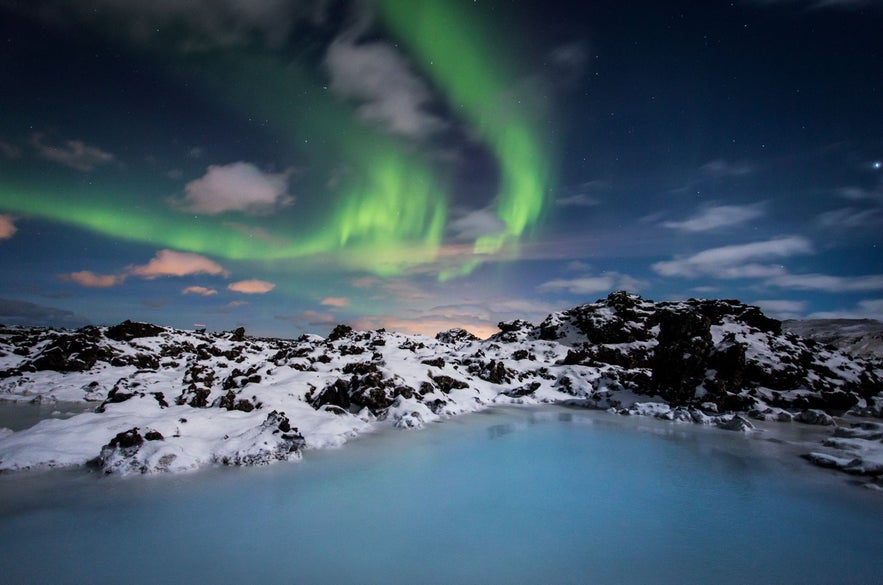 Evenings are particularly atmospheric—perfect after a day of sightseeing tours or adventures like horseback riding and whale watching. In midsummer, late slots let you enjoy the midnight sun. In winter, you might even glimpse the northern lights from the warm water.
Evenings are particularly atmospheric—perfect after a day of sightseeing tours or adventures like horseback riding and whale watching. In midsummer, late slots let you enjoy the midnight sun. In winter, you might even glimpse the northern lights from the warm water.
- Learn more about Iceland in Summer and Iceland in Winter
Blue Lagoon Spa Amenities
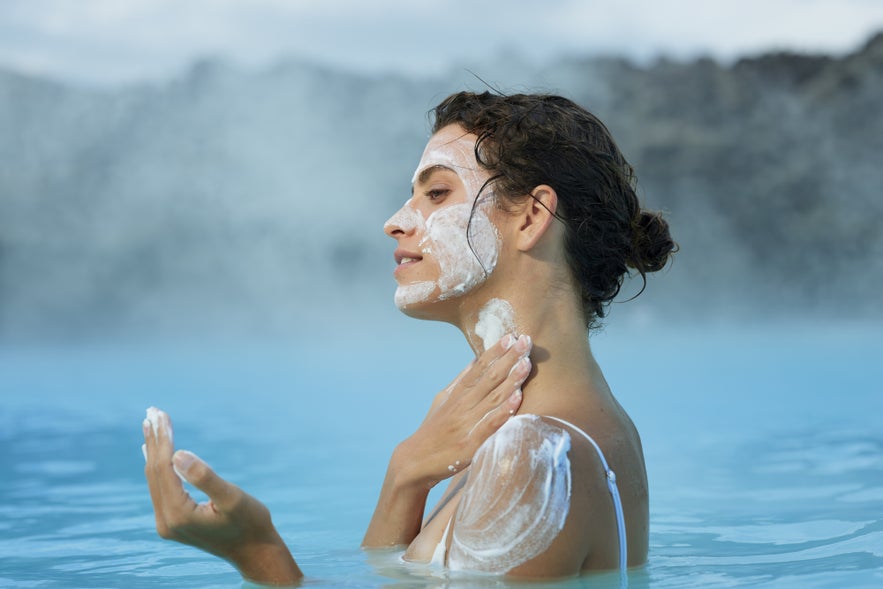 The Blue Lagoon offers several spa amenities to all guests. These include a silica mud mask, sauna and steam rooms, a human-made waterfall, a relaxation cave, a swim-up bar, the option to book an in-water massage, and an indoor relaxation area with a view.
The Blue Lagoon offers several spa amenities to all guests. These include a silica mud mask, sauna and steam rooms, a human-made waterfall, a relaxation cave, a swim-up bar, the option to book an in-water massage, and an indoor relaxation area with a view.
You can get the silica mud mask from the mud bars inside the lagoon. Cover your face with the white silica mask (avoid the eye area), let it rest for a few minutes, and then wash it off for silky-smooth skin.
There's also a traditional Finnish wooden sauna and a steam bath with a window out to the lagoon. Next to the sauna is a human-made waterfall whose warm pressure soothes tight shoulders.
Enter the cave to listen to an audio guide about the Blue Lagoon in several languages. It's also the perfect spot for photos.
Blue Lagoon Swim-Up Bar
 The bar is inside the lagoon, and you can purchase alcoholic and nonalcoholic drinks with the electronic wristband you received on arrival. You'll settle your bill when you exit the premises. Remember to stay hydrated while soaking.
The bar is inside the lagoon, and you can purchase alcoholic and nonalcoholic drinks with the electronic wristband you received on arrival. You'll settle your bill when you exit the premises. Remember to stay hydrated while soaking.
Blue Lagoon In-Water Massages
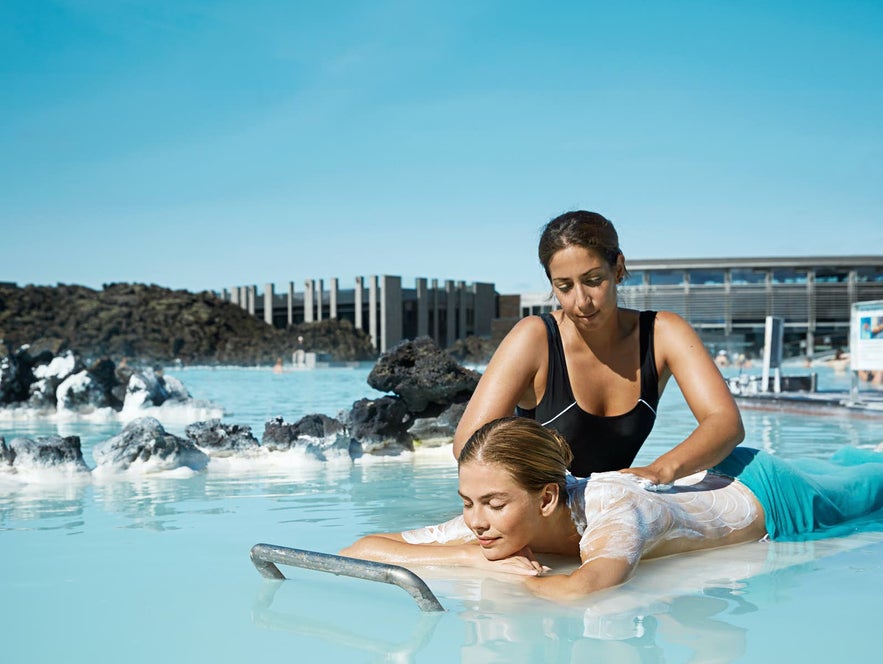
Experience ultimate relaxation with Blue Lagoon's unique in-water massages. Treatments are performed while you float in the warm, mineral-rich waters, supported by a flotation mat and draped in a warm blanket for comfort.
Blue Lagoon Massage Options
-
Relaxing in-water massage: 30–60 minutes. Prices typically start from ISK 20,900 per person.
-
Relaxing in-water massage with full-body silica salt scrub: 60–90 minutes. Prices typically start from ISK 33,900 per person.
-
Signature in-water massage: 120 minutes. Prices typically start from ISK 52,900 per person.
Due to high demand, booking your in-water massage well in advance is strongly recommended. Note that treatment prices do not include admission to the Blue Lagoon; admission must be purchased separately.
Blue Lagoon Skin Products
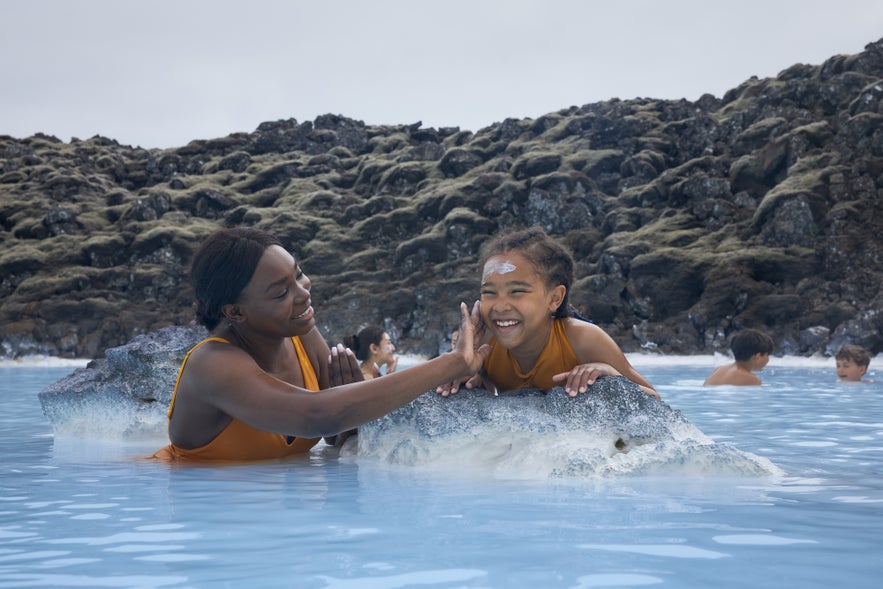
The Blue Lagoon is famous for its skincare line, Blue Lagoon Skincare. In the lagoon itself, all guests are treated to the silica mud mask and can purchase the algae or mineral masks for use in the water. You can also buy these products, along with many others, to take home.
You'll find Blue Lagoon Skincare products available at the Blue Lagoon itself, as well as in their stores located on Laugavegur Street, in the Kringlan Shopping Mall, and at Keflavik Airport.
Although the algae and silica mud masks are bestsellers, there's a wide range of additional products like bath salts, body lotion, hand cream, creams, lip balm, and more. Check out our review of some of their top products.
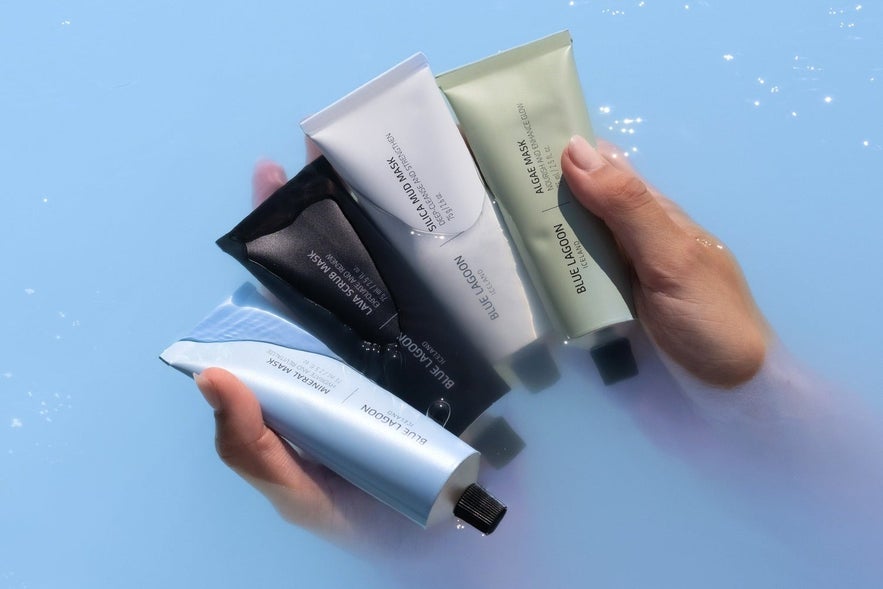 The first five products were released in 1993 and focused on treatments. In the following decades, the skincare line expanded into cleansing, boosting, healing, and nourishing products.
The first five products were released in 1993 and focused on treatments. In the following decades, the skincare line expanded into cleansing, boosting, healing, and nourishing products.
The algae are prized for their nourishing properties, while silica helps strengthen the skin barrier and gives the lagoon its characteristic blue hue. The skincare line follows an eco-minded approach, with key bioactive elements harvested via low-waste methods. Guests can also use the Blue Lagoon hair conditioner in the showers.
Where to Eat at the Blue Lagoon
 A visit to the Blue Lagoon is more than a soak in geothermal waters; it’s an immersive experience complete with unique dining options. From gourmet meals to casual bites, the Blue Lagoon offers a range of choices to suit every palate.
A visit to the Blue Lagoon is more than a soak in geothermal waters; it’s an immersive experience complete with unique dining options. From gourmet meals to casual bites, the Blue Lagoon offers a range of choices to suit every palate.
Lava Restaurant
-
Opening hours: Daily from 11:30 AM to 9 PM
-
Attire: Relaxed fine dining
The Lava Restaurant is a top-notch restaurant with a view of the water. It provides you with the perfect stop for a romantic meal before or after soothing your muscles in the water. The restaurant is also suitable for relaxed lunches or family dinners.
The restaurant's design is gorgeous and uses the natural lava rocks as decoration. Built into the lava rock, floor-to-ceiling windows allow diners to view the blue waters.
As expected at a spa resort, Lava Restaurant is a little upscale, and the prices reflect that. Expect to pay a similar amount for your meal as you do for the entry to the lagoon. But the food is delicious, so this gourmet treat is worth it for foodies.
The food is mainly forged from traditional Icelandic ingredients. The menu changes regularly, although some favorite dishes remain the same.
You can expect to see Icelandic food classics such as lamb, arctic char, root vegetables, langoustine, cod, and beef, along with Icelandic herbs, berries, and, of course, the traditional Icelandic dairy product, Skyr yogurt.
A highly recommended four-course tasting menu is available for the whole table, and a children's menu is also on offer. There are also some vegetarian options on the menu. You can purchase an accompanying wine menu or buy drinks by the glass.
Moss Restaurant at Blue Lagoon Retreat
-
Opening hours: Wednesdays to Sundays from 6 PM
-
Attire: Fine casual
The newest addition to the Blue Lagoon is the Michelin star Moss Restaurant. The menu is seasonal but relies on fresh Icelandic ingredients. It's located on top of The Retreat Spa, giving customers beautiful views over the surrounding lava landscapes through wall-to-wall windows.
High-quality ingredients fill the menu, sourced straight from farmers across Iceland. A team of esteemed chefs develops the meals and dedicates itself to getting to know the producers and the product. We highly recommend making dinner reservations.
Spa Restaurant
-
Opening hours: Daily from 12 PM to 8 PM with breakfast from 8 AM to 10:30 AM
-
Attire: Casual
If you're enjoying the services provided at The Retreat Spa, you can also visit the in-house Spa Restaurant for a bite to eat.
No reservations are necessary, and you're invited to dine in your bathrobe or fully clothed.
The small menu features dishes like smoked salmon, avocado toast, chicken salad, and pancakes with berries and vanilla ice cream. Various wines, coffees, hot teas, and hot chocolate are also available.
Blue Cafe
-
Opening hours: Daily from 8 AM to 10 PM
-
Attire: Casual
The fourth option for eating at the Blue Lagoon is a cafe, open daily between 08:00 and 21:00. Visitors can stop by and grab light snacks and refreshments while still enjoying a view of the lagoon.
The café serves breakfast in the morning, making it an ideal stop for travelers arriving on early flights from the airport.
- See also: Best Restaurants in Reykjavik
Hotels Near the Blue Lagoon
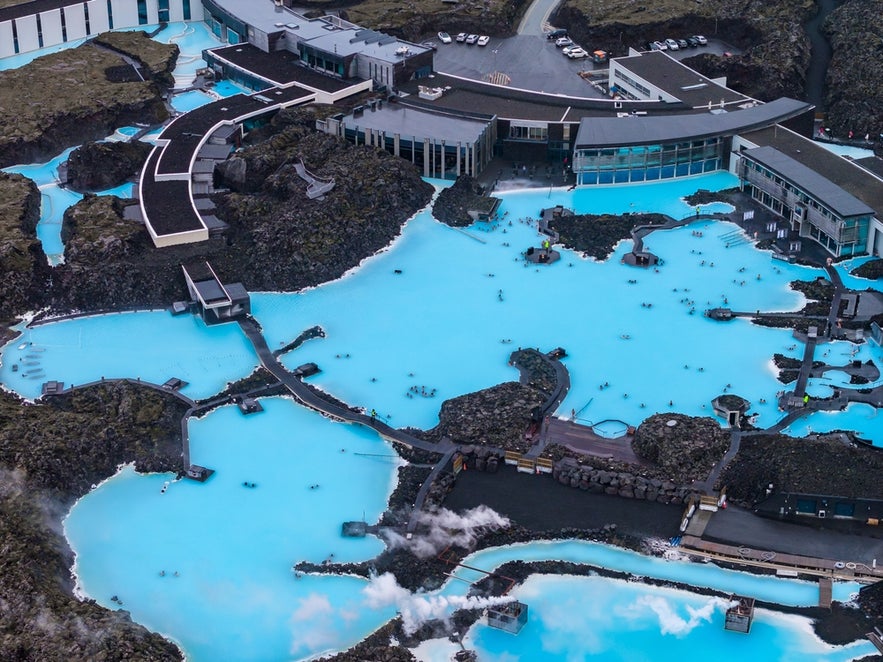 You can find many great hotels near the Blue Lagoon and places to stay all over the beautiful Reykjanes peninsula, such as Keflavik accommodations.
You can find many great hotels near the Blue Lagoon and places to stay all over the beautiful Reykjanes peninsula, such as Keflavik accommodations.
Whether you’re on a short stopover, beginning or ending your Icelandic adventure, or simply seeking relaxation, these accommodations provide a peaceful retreat just minutes from the rejuvenating waters of the Blue Lagoon.
From modern amenities to scenic surroundings, each hotel offers a unique experience, blending Icelandic charm with convenient access to one of the country's top attractions.
Blue Lagoon Silica Hotel
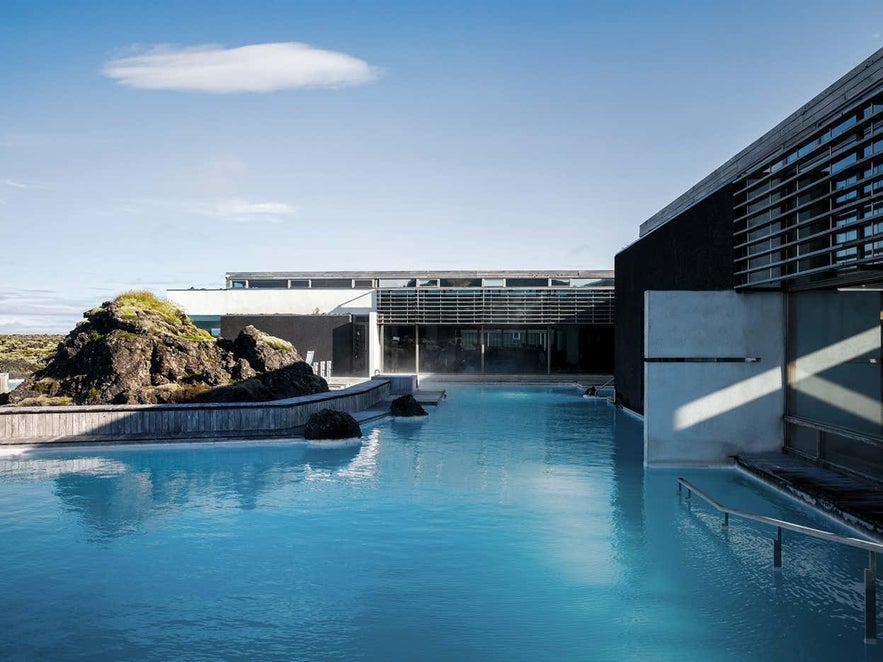 The Silica Hotel is a modern luxury hotel that's a part of the Blue Lagoon. Surrounded by lava fields, it offers quiet surroundings and easy access to popular sites in the Reykjanes Peninsula.
The Silica Hotel is a modern luxury hotel that's a part of the Blue Lagoon. Surrounded by lava fields, it offers quiet surroundings and easy access to popular sites in the Reykjanes Peninsula.
One of the main features of the hotel is its private lagoon, which is only available to hotel guests. It’s a calm place to relax in warm, mineral-rich water without the crowds.
The hotel has clean, comfortable rooms with large windows, natural light, and free Wi-Fi. Each stay includes a complimentary breakfast, and guests can have lunch or dinner at the Lava Restaurant, just a short walk away.
With comfortable rooms, helpful staff, and a private bathing area, the Silica Hotel is a good choice for travelers who want a quiet stay close to the Blue Lagoon and nearby attractions.
- See also: The Most Romantic Places in Iceland
The Retreat at Blue Lagoon
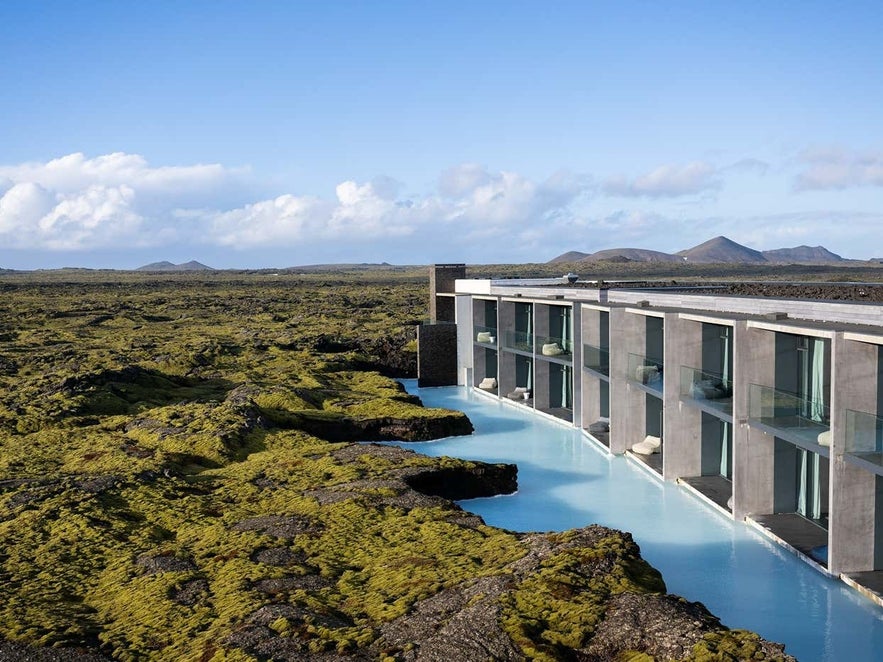 The Blue Lagoon Retreat Hotel is a five-star luxury hotel connected to the Blue Lagoon. It’s set in a quiet area surrounded by lava fields and offers easy access to the geothermal spa and other nearby sights in the Reykjanes Peninsula.
The Blue Lagoon Retreat Hotel is a five-star luxury hotel connected to the Blue Lagoon. It’s set in a quiet area surrounded by lava fields and offers easy access to the geothermal spa and other nearby sights in the Reykjanes Peninsula.
Guests staying at the Retreat have access to a private section of the Blue Lagoon, along with the Retreat Spa, which includes steam rooms, a lava cave, and a range of relaxing treatments. Note: Retreat Spa and Retreat Lagoon are for ages 12+ and require separate spa admission unless included in your hotel package.
Suites are spacious and modern, with floor-to-ceiling windows, scenic views, and features like free Wi-Fi and in-room breakfast. Guests can also enjoy fine dining at Moss Restaurant, which serves seasonal Icelandic dishes.
With high-end service, private lagoon access, and luxurious amenities, the Retreat Hotel is a top choice for travelers looking for luxury, comfort, privacy, and a full spa experience at the Blue Lagoon.
Courtyard by Marriott Keflavik Airport
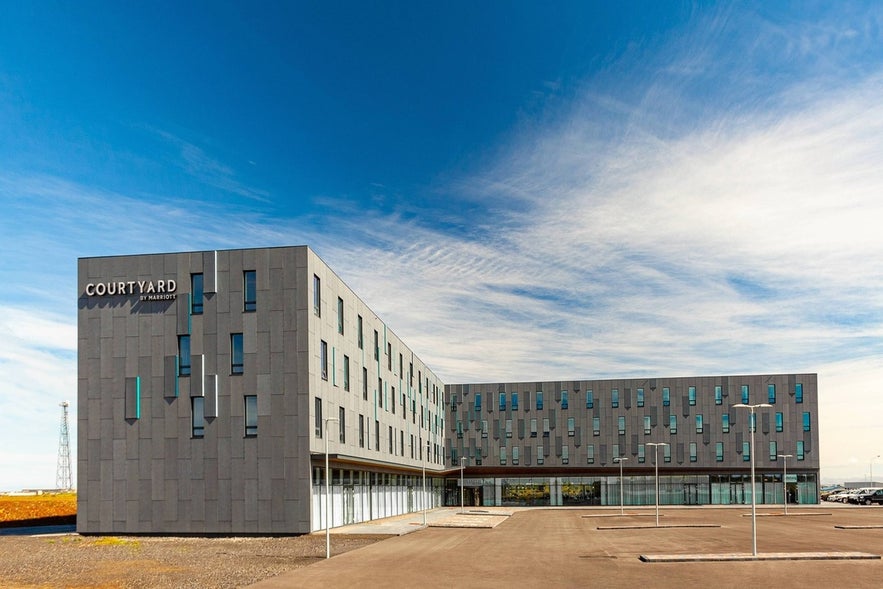 The Courtyard by Marriott Reykjavik Keflavik Airport offers luxury and convenience just 0.8 miles (1.3 km) from Keflavik Airport, ideal for business and leisure travelers. Located on Iceland’s Reykjanes Peninsula, the hotel provides easy access to the Blue Lagoon, only 13 miles (21 km) away.
The Courtyard by Marriott Reykjavik Keflavik Airport offers luxury and convenience just 0.8 miles (1.3 km) from Keflavik Airport, ideal for business and leisure travelers. Located on Iceland’s Reykjanes Peninsula, the hotel provides easy access to the Blue Lagoon, only 13 miles (21 km) away.
You can also visit natural sites like the Gunnuhver Hot Spring and the Bridge Between Continents. Keflavik’s nearby dining and cultural attractions, including the Reykjanes Art Museum and Viking World, add to the experience.
The Courtyard by Marriott Reykjavik has a lovely on-site restaurant, perfect for a nice meal in the area.
The hotel’s rooms feature blackout curtains, high-speed Wi-Fi, and flat-screen TVs, ensuring a comfortable stay. Guests can relax in shared lounges or use the fully equipped gym. With event spaces and a convenient event planning app, the hotel is also ideal for meetings and celebrations.
Northern Light Inn
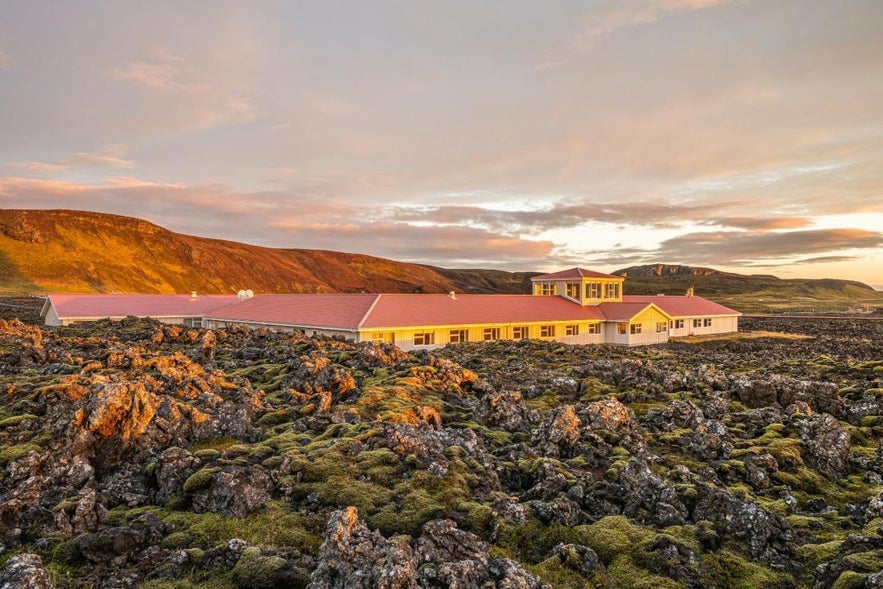 Experience comfort and relaxation at the Northern Light Inn, an elegant hotel just 0.9 miles (1.5 kilometers) from the Blue Lagoon. The inn also offers easy access to the Bridge Between Continents, the vibrant Krysuvik Geothermal Area, and the Viking World Museum.
Experience comfort and relaxation at the Northern Light Inn, an elegant hotel just 0.9 miles (1.5 kilometers) from the Blue Lagoon. The inn also offers easy access to the Bridge Between Continents, the vibrant Krysuvik Geothermal Area, and the Viking World Museum.
The Northern Light Inn offers an array of amenities designed for a restful stay. Guests can enjoy the on-site wellness spa, which features saunas, massage treatments, and flotation therapy.
Stay active in the fully equipped gym, and indulge in daily meals at Max’s, the on-site restaurant with panoramic countryside views.
This three-star hotel also offers cozy rooms with free Wi-Fi, a fireplace lounge, and free parking. Choose the Northern Light Inn for convenience, quality amenities, and proximity to the best of Iceland’s attractions on the Reykjanes Peninsula.
Things To Do Near The Blue Lagoon
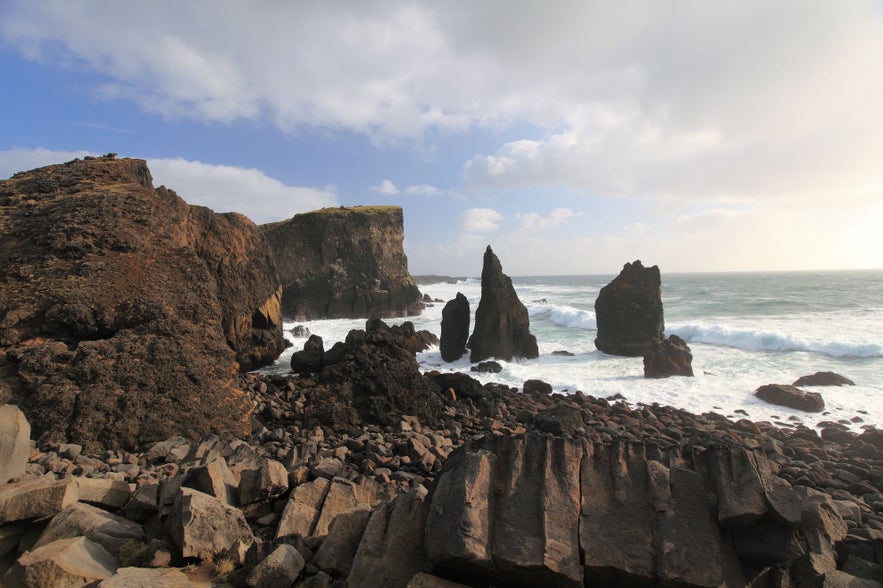
The Blue Lagoon sits on the Reykjanes Peninsula. Visitors to Iceland often overlook this area, as they only see it on the journey to and from the airport. However, the peninsula has plenty of beautiful attractions to admire and won't have hordes of tourists around.
Attractions in the area include countless craters, the geothermal area of Krysuvik, Gunnuhver Hot Springs, Lake Kleifarvatn, the Bridge Between Continents, the natural pool Brimketill, and the town of Keflavik.
Explore the rugged region with these top-rated Reykjanes Peninsula tours:
-
Small Group 6-Hour Reykjanes Tour with Blue Lagoon: Explore the highlights of the Reykjanes Peninsula in a small group and end the day with a relaxing soak in the Blue Lagoon.
-
Volcano Hike and Sightseeing Tour in the Reykjanes Peninsula Starting from Reykjavik: Take a guided hike through the volcanic landscapes of Fagradalsfjall Volcano and see geothermal and coastal sights on this day tour from Reykjavik.
-
Hiking Tour to the Reykjanes Volcano Area with a Blue Lagoon Admission: Join a hike to the active volcano area in Reykjanes, then unwind with a visit to the Blue Lagoon.
Explore Geothermal Spots
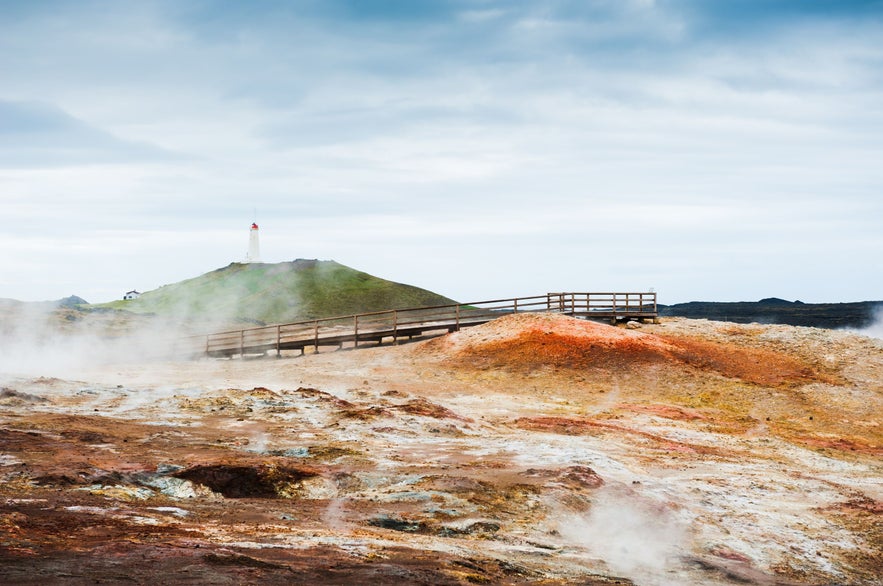 The Reykjanes Peninsula has its fair share of geothermal areas. The most well-known, geothermally active ones are Seltun in Krysuvik, near Lake Kleifarvatn, and Gunnuhver, closer to the Blue Lagoon.
The Reykjanes Peninsula has its fair share of geothermal areas. The most well-known, geothermally active ones are Seltun in Krysuvik, near Lake Kleifarvatn, and Gunnuhver, closer to the Blue Lagoon.
Seltun is a colorful area featuring bright yellow, orange, red, and green-toned earth. It has a wooden path that snakes past boiling mud pots, hot springs, and hissing fumaroles, as well as many educational signs in the area.
Gunnuhver is a large hot spring area with fumaroles and mud pools that are too hot for bathing. This place has a haunted past, with a peasant woman's murderous ghost said to be trapped in the steam.
- Read more about Geothermal Areas in Iceland
- See also: Have you met the angry Ghost at Gunnuhver Mud Pool in Reykjanes?
Visit Lake Kleifarvatn
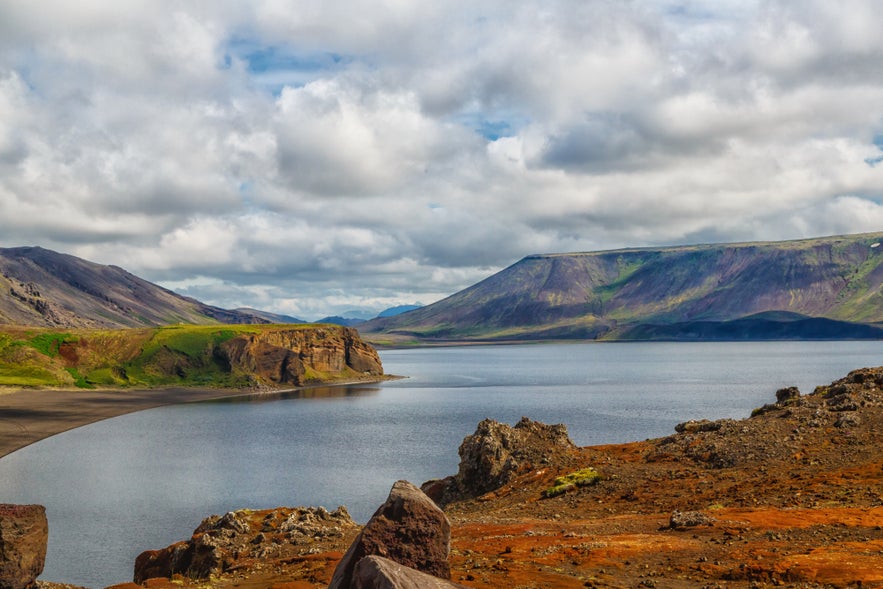 Lake Kleifarvatn is the largest lake on the Reykjanes Peninsula and the 26th largest lake in Iceland, at about 5.5 square miles (9 square kilometers).
Lake Kleifarvatn is the largest lake on the Reykjanes Peninsula and the 26th largest lake in Iceland, at about 5.5 square miles (9 square kilometers).
At its deepest, it’s around 295 feet (90 meters), making it one of the deeper lakes in Iceland. However, a couple of earthquakes in 2000 opened a crack that made the water level drop.
As a result, the lake's coastline is fascinating, with steam from hot springs rising around it and gorgeous lava flow rock formations that are well worth exploring.
Walk the Bridge Between Continents
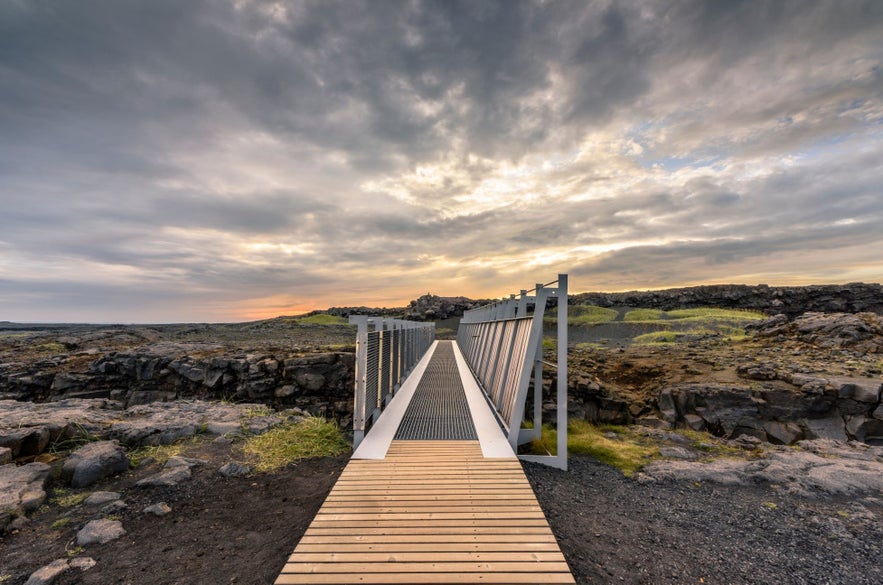
The Bridge Between Continents is a unique site where visitors can walk between the North American and Eurasian tectonic plates. This footbridge spans a rift valley created by the plates drifting apart, offering a chance to stand between two continents.
You can also hike up the cone-shaped Keilir Mountain or visit the Leidarendi Lava Cave by the Blafjoll Blue Mountains.
View the Brimketill Natural Pool

Brimketill, or the Whitewater Cauldron, is a naturally shaped lava rock pool by the seaside. It's a beautiful natural formation that makes for great photographs.
However, it’s filled with freezing cold seawater that shouldn't be entered, especially during high tide or in windy weather. Enormous waves continually crash on it, but a safe viewing platform is close by and accessible to everyone.
Visit the Reykjanes Volcano
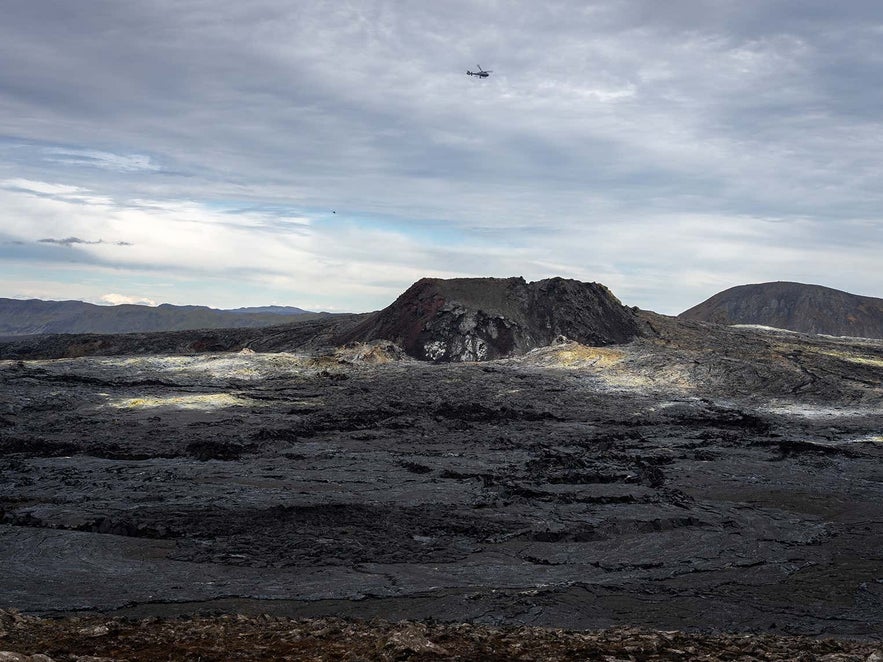 The Reykjanes Peninsula has become one of Iceland’s most fascinating geological sites due to recent volcanic activity. The recent eruptions on the Reykjanes Peninsula, by Sundhnukagigar Craters, Mt. Litli-Hrutur, and Fagradalsfjall Mountain, have transformed the landscape, creating vast lava fields and steaming craters.
The Reykjanes Peninsula has become one of Iceland’s most fascinating geological sites due to recent volcanic activity. The recent eruptions on the Reykjanes Peninsula, by Sundhnukagigar Craters, Mt. Litli-Hrutur, and Fagradalsfjall Mountain, have transformed the landscape, creating vast lava fields and steaming craters.
While access to the area depends on safety conditions, visitors can still witness parts of this dynamic region, hiking to the eruption sites of Fagradalsfjall and Litli-Hrutur mountains.
For a truly breathtaking experience, consider this volcano helicopter tour, offering an aerial view of the volcanic terrain. If you prefer to explore on foot, guided volcano tours provide expert insight into the ever-changing landscape of Reykjanes.
Explore Keflavik Town
 Keflavik is the largest town on the Reykjanes Peninsula. It has some lovely cafes and shops, holds the annual Night of Lights festival at the end of summer, and is home to the Icelandic Museum of Rock ‘n’ Roll.
Keflavik is the largest town on the Reykjanes Peninsula. It has some lovely cafes and shops, holds the annual Night of Lights festival at the end of summer, and is home to the Icelandic Museum of Rock ‘n’ Roll.
The town is near a former U.S. Navy Base that is now university housing and apartment blocks. It's an interesting place where you can still see street names written in English.
You can book an entrance ticket to the Viking World Museum for a unique experience in this area.
Similar Experiences to the Blue Lagoon in Iceland
Although the Blue Lagoon is Iceland's most popular bathing spot, it's hardly the only one. There are several other hot spring experiences and lagoons to explore across the country.
Sky Lagoon
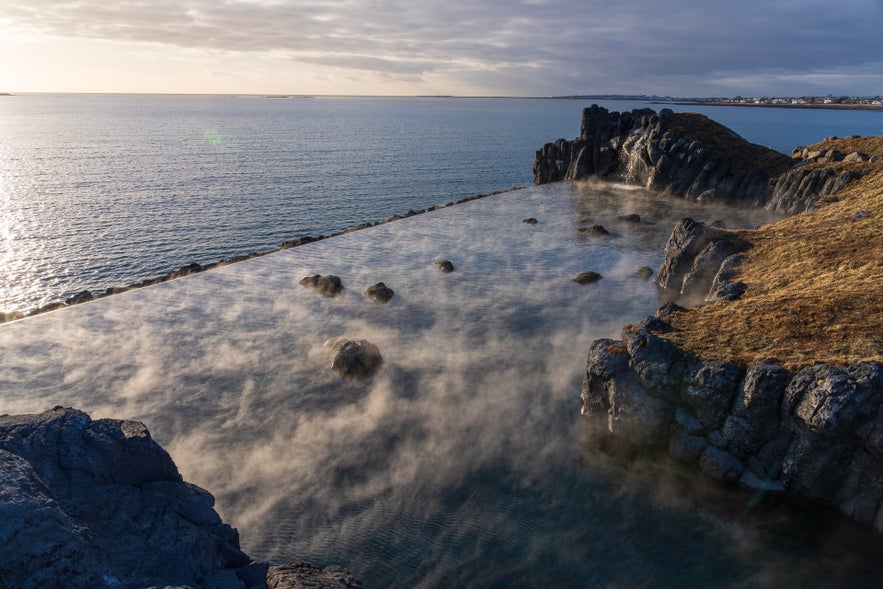 The Sky Lagoon is a breathtaking geothermal spa located in the Capital Region, just a 15-minute drive from downtown Reykjavik. It offers a luxurious and tranquil escape with stunning ocean views.
The Sky Lagoon is a breathtaking geothermal spa located in the Capital Region, just a 15-minute drive from downtown Reykjavik. It offers a luxurious and tranquil escape with stunning ocean views.
Designed to blend seamlessly with Iceland's natural beauty, it features a dramatic infinity-edge pool, a rejuvenating seven-step spa ritual, and modern facilities inspired by Icelandic bathing traditions.
Whether you're seeking relaxation or a unique cultural experience, booking an entry ticket to the Sky Lagoon promises an unforgettable blend of comfort and nature. It's the perfect place to unwind after exploring Iceland's landscapes.
- Read about The Blue Lagoon vs. Sky Lagoon
Hvammsvik Hot Springs
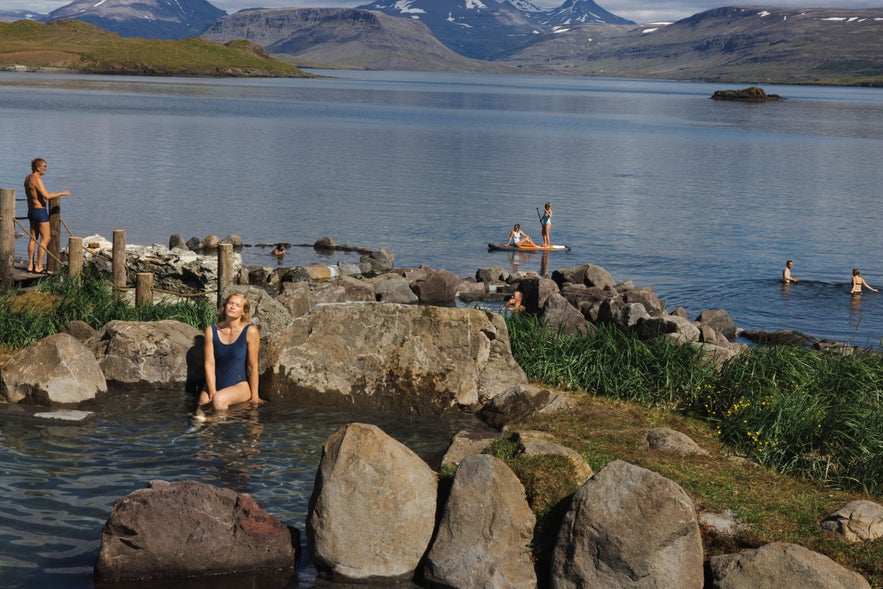 Hvammsvik Hot Springs is a peaceful and scenic place to relax in warm geothermal water surrounded by nature. There are eight natural hot pools, each with different temperatures, offering beautiful views of the ocean and mountains.
Hvammsvik Hot Springs is a peaceful and scenic place to relax in warm geothermal water surrounded by nature. There are eight natural hot pools, each with different temperatures, offering beautiful views of the ocean and mountains.
Unlike many other hot springs, these pools change with the tides, making the experience feel even more connected to nature.
You can book basic Hvammsvik Hot Springs admission or choose admission with transfer from Reykjavik for an easy trip.
Earth Lagoon Myvatn
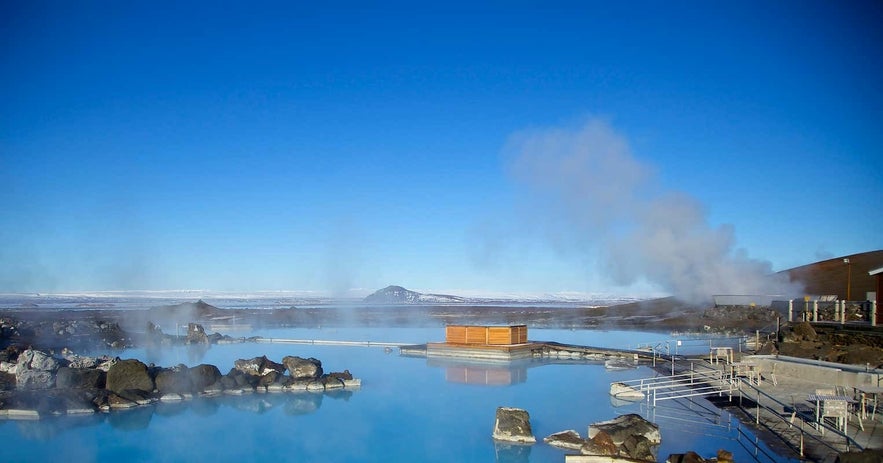 The Earth Lagoon in North Iceland is somewhat comparable to the Blue Lagoon. It was known as Myvatn Nature Baths until October 2025, and this spa has the same blue color as the Blue Lagoon. It has changing facilities, a sauna, and a restaurant/cafe on site.
The Earth Lagoon in North Iceland is somewhat comparable to the Blue Lagoon. It was known as Myvatn Nature Baths until October 2025, and this spa has the same blue color as the Blue Lagoon. It has changing facilities, a sauna, and a restaurant/cafe on site.
The Earth Lagoon is smaller than the Blue Lagoon, receives fewer guests, and is more affordably priced. So, if you are looking for an alternative in the North of Iceland, it’s a good idea to book your Earth Lagoon admission ticket while exploring the region.
The Secret Lagoon
 The Secret Lagoon is found on the South Coast of Iceland, in the Golden Circle area. The water here is nice and toasty but doesn't have the same opaque blue, milky waters as the Blue Lagoon and Earth Lagoon. It does, however, have an adjacent geothermal area.
The Secret Lagoon is found on the South Coast of Iceland, in the Golden Circle area. The water here is nice and toasty but doesn't have the same opaque blue, milky waters as the Blue Lagoon and Earth Lagoon. It does, however, have an adjacent geothermal area.
It's inside a human-made structure, although the water comes straight from the ground. Next to the water, there's a small, bubbling hot spring to remind you of exactly where the hot water originates.
If you are driving through the Golden Circle area, make sure to book your admission to the Secret Lagoon in advance to secure your spot.
History of the Blue Lagoon
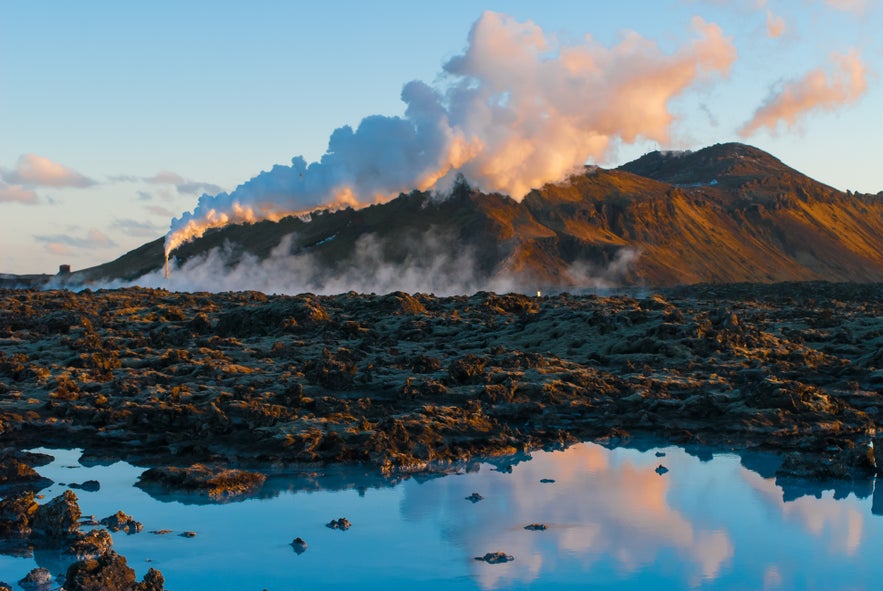
The Blue Lagoon was originally formed in 1976 but its story really begins in 1981, when Valur Margeirsson, seeking relief for psoriasis, bathed in the geothermal waters near the Svartsengi Power Plant.
Seeing its benefits, he named it "Bláa Lónið," and by 1987, basic public bathing facilities opened, attracting locals. Initially simple, with a few showers and a small beach, the lagoon quickly became popular.
In 1999, it was moved further from the plant, adding modern amenities like changing rooms, a cafe, a hotel, and a skincare shop. Walking paths, small bridges, and saunas were also added.
The Blue Lagoon is continually growing, recently expanding from 53,819 square feet (5,000 square meters) to 93,646 square feet (8,700 square meters). Now expanded to accommodate thousands of visitors, the Blue Lagoon is one of Iceland’s top attractions.
FAQs About Iceland’s Blue Lagoon

Here are some of the most common questions about the Blue Lagoon to help you plan your visit!
How Much Does It Cost To Enter the Blue Lagoon?
Prices are dynamic and vary by date and time slot. Adults (14+) pay the listed rate for Comfort, Premium, or Signature packages, while children 2–13 enter free with a guardian. Booking early and choosing early morning or late evening time slots often yields lower prices.
Where Is the Blue Lagoon Located?
The Blue Lagoon is located in the Reykjanes Peninsula, about 14 miles (23 kilometers) from Keflavik Airport and 30 miles (49 kilometers) from Reykjavik. The lagoon is surrounded by stunning volcanic landscapes and geothermal areas.
Is the Blue Lagoon natural?
The Blue Lagoon formed alongside operations at the nearby Svartsengi geothermal power plant. While the lagoon itself is man-made, the geothermal seawater is natural and mineral rich. The lagoon’s ecosystem is self-cleaning (no chlorine), with water naturally renewed roughly every 40 hours.
Why is the water milky blue?
The lagoon’s distinctive color comes primarily from microscopic silica particles suspended in the water that scatter visible light, creating the milky-blue appearance. Algae can lend a greener tint during blooms, especially in sunny conditions.
Why did people start bathing in the Blue Lagoon?
People started bathing in 1981 when Valur Margeirsson sought relief for psoriasis and reported improvements. Word spread, and public bathing facilities opened in 1987.
Is there psoriasis treatment at the Blue Lagoon?
Yes. The Blue Lagoon Medical Clinic (by Silica Hotel) offers programs centered on bathing in geothermal seawater, UVB light therapy, and Blue Lagoon dermatological products. Always consult your doctor for personal medical advice.
What is the design of the Blue Lagoon?
The Blue Lagoon is celebrated for architecture that harmonizes with the lava landscape. From the lava-lined approach path to low-profile buildings of wood and basalt, the design prioritizes immersion in nature. The Lava Restaurant is built around a dramatic lava cliff.
Any other practical tips?
- Bring a swimsuit (rentals are available) and consider flip-flops for comfort on cold days.
- Use plenty of conditioner and avoid submerging hair if you’re concerned about stiffness.
- Remove jewelry and avoid submerging prescription glasses.
- Phones are permitted; use a waterproof case and respect others’ privacy.
- Stay hydrated and take cooling breaks as needed.
Explore the Wonders of Iceland’s Blue Lagoon
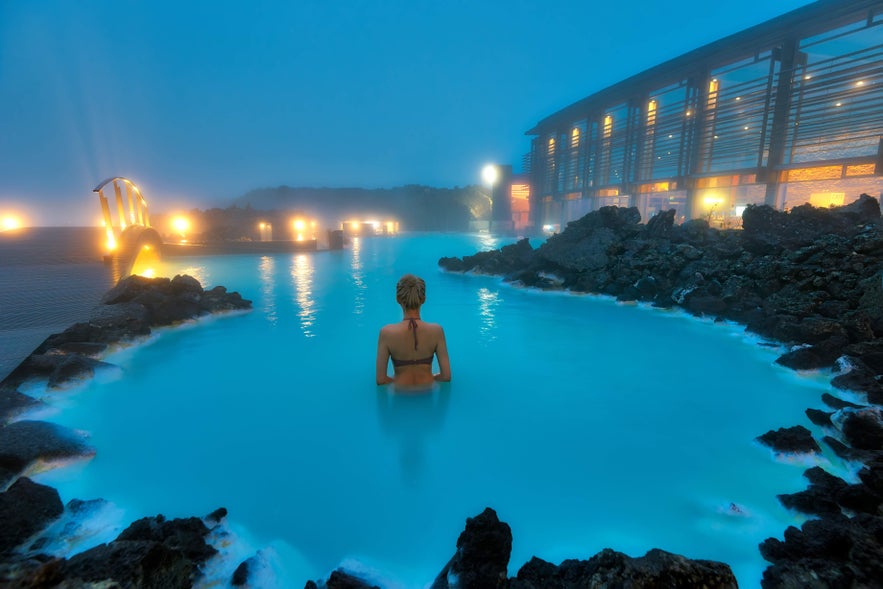 The Blue Lagoon is a must-see destination for anyone visiting Iceland. Whether you're looking to unwind in the warm waters, enjoy a therapeutic mud mask, or indulge in an in-water massage, the Blue Lagoon caters to all kinds of visitors.
The Blue Lagoon is a must-see destination for anyone visiting Iceland. Whether you're looking to unwind in the warm waters, enjoy a therapeutic mud mask, or indulge in an in-water massage, the Blue Lagoon caters to all kinds of visitors.
With easy access from both Reykjavik and Keflavik Airport, it’s the perfect stop during your Icelandic adventure. Whether you explore with guided multi-day tours, day tours, or a self-drive experience, the Blue Lagoon is an experience you won’t want to miss.
We hope our ultimate guide to the Blue Lagoon proved helpful to you in ensuring you make the most of your visit to Iceland. There are many hot springs in Iceland to explore, but the Blue Lagoon should be high on your list. We'd love to hear your questions and comments below!



